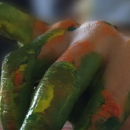Lab:
The Lab is a source of information for Artists and Art Lovers alike. You can find useful information to help develop your career as an artist such as tutorials, interviews, news, and a lot more!

Sharing Art created by people with disabilities: an interview with Flavia Cuñer, director of Art Obert, Sitges, Spain.
Art Obert Sitges [Open Art Sitges] is an art project for people with disabilities. Its first project started in 2008 in collaboration with the Ave María de Sitges Foundation, with sixteen users attending the art classes. Starting from each person’s possibilities and interests, the project has progressed to see if students can grow artistically and personally with individual tutoring.
The way Art Obert works is based on finding the individual possibilities of each student. The authenticity of each artist serves as the starting point. The professors offer various techniques, materials and examples with the goal that the participants can grow as artists. Art Obert’s policy is to neither intervene in nor touch any work. The production process of each work is documented and at the end of every course a collective exhibition is held with all the works.
We’ve spoken with Flavia Cuñer, director of Art Obert, to learn more about Art Brut and to learn first-hand how Art Obert tries to encourage the careers of these artists.
Hello Flavia, thank you very much for accepting this interview request. In the first place we would like to know why and how you created Art Obert.
The association ART OBERT was created starting from a great exhibition organised by a closed group of users from within a foundation. When we created the exhibition and we opened the project and the work to the rest of the community, we saw the need to open it up further and make it accessible to all people who were interested in joining a project with these characteristics. From there and with the collaboration of the Departamento de Cultura del Ayuntamiento de Sitges, Spain [Department of Culture of the Municipal Government of Sitges], we began to create the path independently thanks to the association or artists, educators and users.
Why the interest in what we call l’Art Brut? What is Art Brut exactly?
The interest comes from the need to find a new channel of communication. My professional career has always been closely related to art and special education, so it was not difficult to find this path, I just had to join my two professions.
Once we began developing the workshops, we went about discovering Art Brut or Outsider art and the number of entities dedicated to developing it.
Then we found the path created by the French avant-garde painter Jean Dubuffet, who is, in a manner, the creator of the concept; he defined Art Brut as: “all classes of production that present a spontaneous and strongly imaginative character”, (in French, ‘art in brute’) a term fixed by Dubuffet to design art created by people who are not from the traditional artistic expression forms and cultural values and who paint spontaneously to satisfy an inner need.
Who are the best known artists in Art Brut today? Is there an international market for Art Brut? How does it work?
Currently, the work of Judith Scott has become widely accepted, but there are other artists who have developed successful artistic careers as well.
These artists sell and exhibit their work in galleries across the world, mostly in Europe and the United States. The market generally functions between galleries and museums specialising in Art Brut or Outsider art, though it is also possible to find cases of exhibitions or shows taking place in “conventional” places.

Judith Scott
Have any of the students that have passed through Art Obert managed to build a future for themselves in an artistic career? How have you helped them achieve this?
We have various cases where the students have managed to develop their artistic career and win prizes, always within the artists with disabilities category even though the aesthetic force of their works is frequently vastly superior to the works created by artists without disabilities. We believe that the disability is just one characteristic of a person, it is not in any way the centre of attention. The artists who participate in our workshops have a lot to teach, with many physical or intellectual limitations, they work with such passion and dedication; they are really a great source of inspiration for us and for our guest artists (without disability) who collaborate in the workshops.

Pedro García- Visceralidad creativa

Leyre- Autorretrato

Marta Domínguez Carbonell- La sandía de mi abuelo

Francesc- Autorretrato
How can art help those persons who have a disability?
Plastic arts (drawing, painting, sculptures, murals, modelling, collages), as well as any other artistic discipline, can contribute principally by greatly improving communication and conveying emotions. Simply participating in an activity where it’s possible to feel and interact with materials without limitations or rules, where there are no concepts of good or bad, of incorrect or correct, allows the person to grow, improving their self-esteem and self-knowledge.
Finally I would like to add that each year we go about developing different projects where we depend on one or two guest artists who help with the workshops and the exhibitions, so anyone who is interested in participated shouldn’t hesitate to contact us at [email protected].


